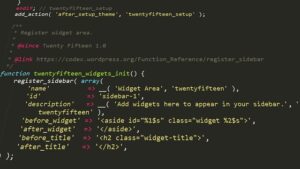Table of Contents
Use synonyms.
How does a Web-based platform that is written entirely in PHP, such as Facebook, employ ReactJS? Can the two technologies be used side-by-side? How can ReactJS help streamline the user experience on such a platform? These are all pertinent questions that this article will address.
There is a major problem for businesses that have invested in a website written with traditional PHP. PHP is a great language, but it can become quite unwieldy when it’s used to create complex web applications. Efficiency is sacrificed, and the amount of coding required to keep the site running smoothly is immense. In addition, the page load time suffers; the more complex the website, the longer it takes to load. This is especially perilous in our mobile-centric world; users demand fast performance regardless of the device they are using. Thankfully, several authoritative sources, such as The Next Web and Venture Beat, have made it clear that ReactJS can help to alleviate this issue.
In this article, you will learn about how ReactJS can be used to streamline the performance of a web application written in PHP, as well as the integration process between the two systems. We will explore how the components of React, such as the virtual DOM and server-side rendering, work to reduce loading time and make user experience smoother. Finally, we will discuss the advantages of using this technique for websites, such as improved performance and scalability, as well as some of the challenges associated with its implementation.Definitions:
Facebook – A popular social media platform that is used by almost all people throughout the world.
Reactjs – An open source JavaScript library developed by Facebook for creating user interfaces.
PHP – An authored language for creating web applications and websites.
As technology is constantly advancing, web developers are always searching for ways to improve their processes and code. For example, Facebook has utilized reactjs as a way to streamline how they develop their products.
Reactjs is an open source JavaScript library developed by Facebook to create user interfaces. With this library, developers can create functional, efficient, and interactive user-interfaces for web applications. Reactjs allows developers to use components to build and deliver the user experience in a more efficient way than traditional coding methods. Plus, it offers the same standards for both web and mobile platforms.
PHP is a powerful language used for building applications and websites. It is very popular and widely used, so web developers can easily work with the language. Facebook, however, has chosen to go with Reactjs instead of using the standard PHP for its development.
Rather than rewriting the same features in multiple languages, Reactjs allows developers to build projects and share code between web and mobile app projects. This helps reduce development time and makes the whole process more efficient.
By utilizing both Reactjs and PHP, Facebook can take advantage of both time and energy savings. Reactjs allows developers to create fully functional user interfaces quickly, while PHP adds the power to build out complex web apps. This combination of the two languages enables Facebook to create a comprehensive platform for their users.
Heading 1: Overview of Facebook’s Utilization of Reactjs
Overview of Facebook’s Utilization of Reactjs
Facebook is increasingly embracing Reactjs as its primary technology for its front-end architecture. Reactjs is a JavaScript library for building user interfaces developed by Facebook, and is used to create components, manage application state, and handle data communication between the front-end and back-end. Reactjs has allowed Facebook to increase its front-end development speed, while also reducing maintenance costs.
Features of Reactjs
Reactjs offers a variety of features, such as:
- Component-based architecture which allows for code reuse.
- Virtual DOM, which makes updates faster since only changes are rendered.
- JSX syntax, which makes the structure of a page easier to understand.
- Server-side rendering, which enables faster perceived loading speeds.
Utilization of Reactjs for Facebook
Reactjs enables Facebook to rapidly develop and implement new features into its interface. It offers a predictable reliability and performance. Reactjs also gives engineers more flexibility, allowing them to design components as reusable pieces that can be integrated throughout the entire application. This reduces the amount of duplicate code, as components are now just shared and combined, rather than rewriting a similar feature more than once.
Reactjs is also being incorporated into Facebook’s internal tooling and CLI. This gives way to faster scaling and development by automated processes. Reactjs also allows Facebook to increase its performance by utilizing features such as lazy loading, which only requests the code used for each page.
Reactjs is a valuable asset to Facebook, allowing the company to keep its development swift and cost-effective. With the help of Reactjs, Facebook is able to quickly iterate its user interface and roll out new features.
Heading 3: Advantages of Combining Reactjs with PHP
Reactjs is an Javascript library that allows developers to create fast and rich user interfaces. It has become increasingly popular in recent years due to its simplicity and flexibility and has gained recognition from Facebook, which decided to use it in its products and services. Therefore, one of the greatest advantages of combining Reactjs with another programming language, such as PHP, is that it increases the overall development speed and reduces the time required to build a website or web application.
Simplification of Complex Designs
Another benefit of using Reactjs with PHP is the simplification of complex designs. By combining two different programming languages, developers are able to create sophisticated designs without having to write a great deal of code. This is achieved by breaking down complex processes into smaller units and using Reactjs to make those processes easier to carry out. This simplification of complex designs makes Reactjs an ideal choice for developers who are looking to develop their website or web application quickly and efficiently.
Seamless Integration
Reactjs also allows for seamless integration of PHP with other programming languages. This can allow for the creation of web applications that are separated into different sections based on programming language but are still connected to each other. This makes it easier for the developer to manage the different sections of the web application. Furthermore, Reactjs makes it easier for developers to make changes to the website or web application if needed, as the programming language is integrated together.
Finally, using Reactjs can also be advantageous when it comes to updating the website or web application. Reactjs’s flexibility allows developers to make changes to the existing code and make the necessary updates quickly. This saves time and money that would otherwise be spent on bug-fixing and resolving issues. Furthermore, Reactjs simplifies the process of creating sites or applications due to its simple structure and easy to learn language.
By combining Reactjs with PHP, developers are able to take advantage of the strengths of both programming languages. This results in high-quality website or web applications that load quickly, feature seamless integration, and can be updated and maintained efficiently. As such, combining Reactjs with PHP is a great way for developers to create reliable and efficient websites and web applications.
Conclusion
.
The use of ReactJS in a project written entirely in PHP presents a number of unique challenges. How will the two technologies work together and how could they be effectively balanced to create an optimized user experience? Having a strong understanding of both languages is paramount for success.
Join us on our blog, where we will showcase some recent news and releases in the world of PHP and ReactJS. We will also discuss how the two languages could work together in harmony to help design awesome user experiences. Be sure to check us out and stay tuned for more.
For more information, please have a look at our Frequently Asked Questions (FAQ) section below.
Q1. What is ReactJS?
ReactJS is a JavaScript library created by the company, Facebook, to build user interfaces. It is widely used for building efficient and dynamic user interfaces and helps developers to build components with the help of the specific browser DOM element.
Q2. When should I use ReactJS?
ReactJS is great for developing user interfaces for dynamic web applications. It is perfect for creating interactive user experiences and gives developers more control over the DOM elements of the user interface.
Q3. Can I use ReactJS and PHP together?
Absolutely! ReactJS and PHP can be used alongside each other to create robust and dynamic web applications. The two languages complement each other perfectly, allowing developers to create powerful user experiences combining the strengths of both.
Q4. What are the advantages of using ReactJS and PHP?
Using ReactJS and PHP together can offer numerous advantages, such as improved performance, scalability, code flexibility, and maintainability. Developers are also able to benefit from the features of each language while creating their user interfaces.
Q5. Where can I find more information about ReactJS and PHP?
You can find more information about ReactJS and PHP on our blog and on various online sources such as books, tutorial websites, and forums. You can also get additional help and advice from other developers and the ReactJS and PHP communities.

